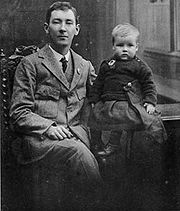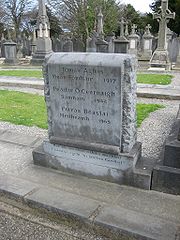
Peadar Kearney
Encyclopedia

Irish Republicanism
Irish republicanism is an ideology based on the belief that all of Ireland should be an independent republic.In 1801, under the Act of Union, the Kingdom of Great Britain and the Kingdom of Ireland merged to form the United Kingdom of Great Britain and Ireland...
and composer of numerous rebel songs
Irish rebel music
Irish rebel music is a subgenre of Irish folk music, with much the same instrumentation, but with lyrics predominantly concerned with Irish republicanism.-History:...
. In 1907 he wrote the lyrics to "The Soldier's Song
Amhrán na bhFiann
is the national anthem of Ireland. The music was composed by Peadar Kearney and Patrick Heeney, and the original English lyrics were authored by Kearney. It is sung in the Irish language translation made by Liam Ó Rinn. The song has three verses, but the national anthem consists of the chorus only...
" ("Amhrán na bhFiann"), now the Irish
Republic of Ireland
Ireland , described as the Republic of Ireland , is a sovereign state in Europe occupying approximately five-sixths of the island of the same name. Its capital is Dublin. Ireland, which had a population of 4.58 million in 2011, is a constitutional republic governed as a parliamentary democracy,...
national anthem
National anthem
A national anthem is a generally patriotic musical composition that evokes and eulogizes the history, traditions and struggles of its people, recognized either by a nation's government as the official national song, or by convention through use by the people.- History :Anthems rose to prominence...
.
Background
Kearney was born at 68 Lower Dorset Street, Dublin in 1883. His father was from Louth and his mother was originally from MeathCounty Meath
County Meath is a county in Ireland. It is part of the Mid-East Region and is also located in the province of Leinster. It is named after the ancient Kingdom of Mide . Meath County Council is the local authority for the county...
. He was educated at the Model School, Schoolhouse Lane and St Joseph's Christian Brothers School in Fairview, Dublin
Fairview, Dublin
Fairview is a coastal district on the Northside of Dublin, Ireland, in the jurisdiction of Dublin City Council. Part of the area forms Fairview Park, on land reclaimed from the sea.-Location and access:...
. He left school at the age of 14, becoming an apprentice house painter.
Political activity
Kearney joined the Gaelic League in 1901, and joined the Irish Republican BrotherhoodIrish Republican Brotherhood
The Irish Republican Brotherhood was a secret oath-bound fraternal organisation dedicated to the establishment of an "independent democratic republic" in Ireland during the second half of the 19th century and the start of the 20th century...
in 1903. He taught night classes in Irish and numbered Sean O'Casey
Seán O'Casey
Seán O'Casey was an Irish dramatist and memoirist. A committed socialist, he was the first Irish playwright of note to write about the Dublin working classes.- Early life:...
among his pupils. He found work with the National Theatre Society and in 1904 was one of the first to inspect the derelict building that became the Abbey Theatre
Abbey Theatre
The Abbey Theatre , also known as the National Theatre of Ireland , is a theatre located in Dublin, Ireland. The Abbey first opened its doors to the public on 27 December 1904. Despite losing its original building to a fire in 1951, it has remained active to the present day...
, which opened its doors on 27 December of that year. He assisted with props and performed occasional walk-on parts at the Abbey until 1916.
Kearney was a co-founder of the Irish Volunteers
Irish Volunteers
The Irish Volunteers was a military organisation established in 1913 by Irish nationalists. It was ostensibly formed in response to the formation of the Ulster Volunteers in 1912, and its declared primary aim was "to secure and maintain the rights and liberties common to the whole people of Ireland"...
in 1913. He took part in the Howth
Howth
Howth is an area in Fingal County near Dublin city in Ireland. Originally just a small fishing village, Howth with its surrounding rural district is now a busy suburb of Dublin, with a mix of dense residential development and wild hillside, all on the peninsula of Howth Head. The only...
and Kilcoole
Kilcoole
Kilcoole is a village in County Wicklow, Ireland. It is three kilometres south of Greystones, 14 kilometres north of Wicklow, and about 25 kilometres south of Dublin. It was used as the set for the Irish television series Glenroe, which ran through the 1980s and 1990s...
gun runnings in 1914. In the Easter Rising
Easter Rising
The Easter Rising was an insurrection staged in Ireland during Easter Week, 1916. The Rising was mounted by Irish republicans with the aims of ending British rule in Ireland and establishing the Irish Republic at a time when the British Empire was heavily engaged in the First World War...
of 1916 Kearney fought at Jacob's biscuit factory under Thomas MacDonagh
Thomas MacDonagh
Thomas MacDonagh was an Irish nationalist, poet, playwright, and a leader of the 1916 Easter Rising.-Early life:MacDonagh was born in Cloughjordan, County Tipperary...
, abandoning an Abbey Theatre tour in England in order to take part in the Rising. He escaped before the garrison was taken into custody.
He was active in the War of Independence
Irish War of Independence
The Irish War of Independence , Anglo-Irish War, Black and Tan War, or Tan War was a guerrilla war mounted by the Irish Republican Army against the British government and its forces in Ireland. It began in January 1919, following the Irish Republic's declaration of independence. Both sides agreed...
. On 25 November 1920 he was captured at his home in Summerhill, Dublin and was interned first in Collinstown
Collinstown
Collinstown is an expanding village in County Westmeath, situated on the R395 regional road 18 km northeast of the county town of Mullingar. Collinstown is in St Mary's parish and has a population of approaching 700.-Name:...
Camp in Dublin and later in Ballykinler
Ballykinler
Ballykinler or Ballykinlar is a village in County Down, Northern Ireland. It lies 12 kilometres south west of Downpatrick, in the parish of Tyrella and Dundrum. In the 2001 Census it had a population of 348 people. It is within the Down District Council area.It is a linear settlement running...
Camp in County Down
County Down
-Cities:*Belfast *Newry -Large towns:*Dundonald*Newtownards*Bangor-Medium towns:...
.
A personal friend of Michael Collins
Michael Collins (Irish leader)
Michael "Mick" Collins was an Irish revolutionary leader, Minister for Finance and Teachta Dála for Cork South in the First Dáil of 1919, Director of Intelligence for the IRA, and member of the Irish delegation during the Anglo-Irish Treaty negotiations. Subsequently, he was both Chairman of the...
, Kearney at first took the Free State
Irish Free State
The Irish Free State was the state established as a Dominion on 6 December 1922 under the Anglo-Irish Treaty, signed by the British government and Irish representatives exactly twelve months beforehand...
side in the Civil War
Irish Civil War
The Irish Civil War was a conflict that accompanied the establishment of the Irish Free State as an entity independent from the United Kingdom within the British Empire....
but lost faith in the Free State after Collins's death. He took no further part in politics, returning to his original trade of house painting. Kearney died in relative poverty in Inchicore
Inchicore
-Location and access:Located five kilometres due west of the city centre, Inchicore lies south of the River Liffey, west of Kilmainham, north of Drimnagh and east of Ballyfermot. The majority of Inchicore is in the Dublin 8 postal district...
in 1942. He is buried in Glasnevin Cemetery
Glasnevin Cemetery
Glasnevin Cemetery , officially known as Prospect Cemetery, is the largest non-denominational cemetery in Ireland with an estimated 1.5 million burials...
in Dublin. He was survived by his wife Eva and two sons, Pearse and Con.

Songs and legacy
Kearney's songs were highly popular with the Volunteers (which later became the IRAIrish Republican Army
The Irish Republican Army was an Irish republican revolutionary military organisation. It was descended from the Irish Volunteers, an organisation established on 25 November 1913 that staged the Easter Rising in April 1916...
) in the 1913-22 period. Most popular was "The Soldier's Song". Kearney penned the original English lyrics in 1907 and his friend and musical collaborator Patrick Heeney
Patrick Heeney
Patrick "Paddy" Heeney , sometimes spelt Heaney, was an Irish composer whose most famous work is the music to the Irish national anthem "Amhrán na bhFiann" .-Background:...
composed the music. The lyrics were published in 1912 and the music in 1916. In 1926, four years after the formation of the Free State, the Irish translation, "Amhrán na bhFiann", was adopted as the national anthem, replacing God Save Ireland
God Save Ireland
"God Save Ireland" is an Irish rebel song. It served as an unofficial Irish national anthem for Irish nationalists from the 1870s to the 1910s. During the Parnellite split it was the anthem of the anti-Parnellite Irish National Federation....
. Kearney was not paid royalties for his contribution to the song.
Other well-known songs by Kearney include "Down by the Glenside (The Bold Fenian Men)
Down by the Glenside (The Bold Fenian Men)
"Down by the Glenside " is an Irish rebel song written by Peadar Kearney, an Irish Republican and composer of numerous rebel songs, including "The Soldier's Song" , now the Irish National Anthem....
", "The Tri-coloured Ribbon", "Down by the Liffey Side" and "Erin Go Bragh" (Erin Go Bragh
Erin Go Bragh
Erin go Bragh , sometimes Erin go Braugh, is the anglicisation of a Gaelic phrase, and is used to express allegiance to Ireland. It is most often translated as "Ireland Forever."-Origin:...
was the text on the Irish national
Irish nationalism
Irish nationalism manifests itself in political and social movements and in sentiment inspired by a love for Irish culture, language and history, and as a sense of pride in Ireland and in the Irish people...
flag before the adoption of the tricolour
Flag of Ireland
The national flag of Ireland is a vertical tricolour of green , white, and orange. It is also known as the Irish tricolour. The flag proportion is 1:2...
).
Kearney's sister Kathleen was the mother of Irish writers
Irish literature
For a comparatively small island, Ireland has made a disproportionately large contribution to world literature. Irish literature encompasses the Irish and English languages.-The beginning of writing in Irish:...
Brendan Behan
Brendan Behan
Brendan Francis Behan was an Irish poet, short story writer, novelist, and playwright who wrote in both Irish and English. He was also an Irish republican and a volunteer in the Irish Republican Army.-Early life:...
and Dominic Behan
Dominic Behan
Dominic Behan was an Irish songwriter, short story writer, novelist and playwright who wrote in both Irish and English. He was also a committed socialist and Irish Republican...
, both of whom were also republicans and songwriters. Brendan Behan was in prison when Kearney died, and was refused permission to attend his funeral. In a letter to Kearney's son, Pearse, he said, "my Uncle Peadar was the one, outside my own parents, who excited the admiration and love that is friendship."
In 1957 his nephew Seamus de Burca (or Jimmy Bourke son of Kearney's sister, Margaret) published a biography of Kearney, The Soldier’s Song: The Story of Peadar Ó Cearnaigh. In 1976 De Burca also published Kearney's letters to his wife written during his internment in 1921 were published as My Dear Eva ... Letters from Ballykinlar Internment Camp, 1921. A wall plaque on the west side of Dorset Street commemorates his birth there.
External links
- Images of 'personal mementos, manuscripts, documents, photographs and personal ephemera' from Whyte's Auctioneers (Includes brief bio.).

